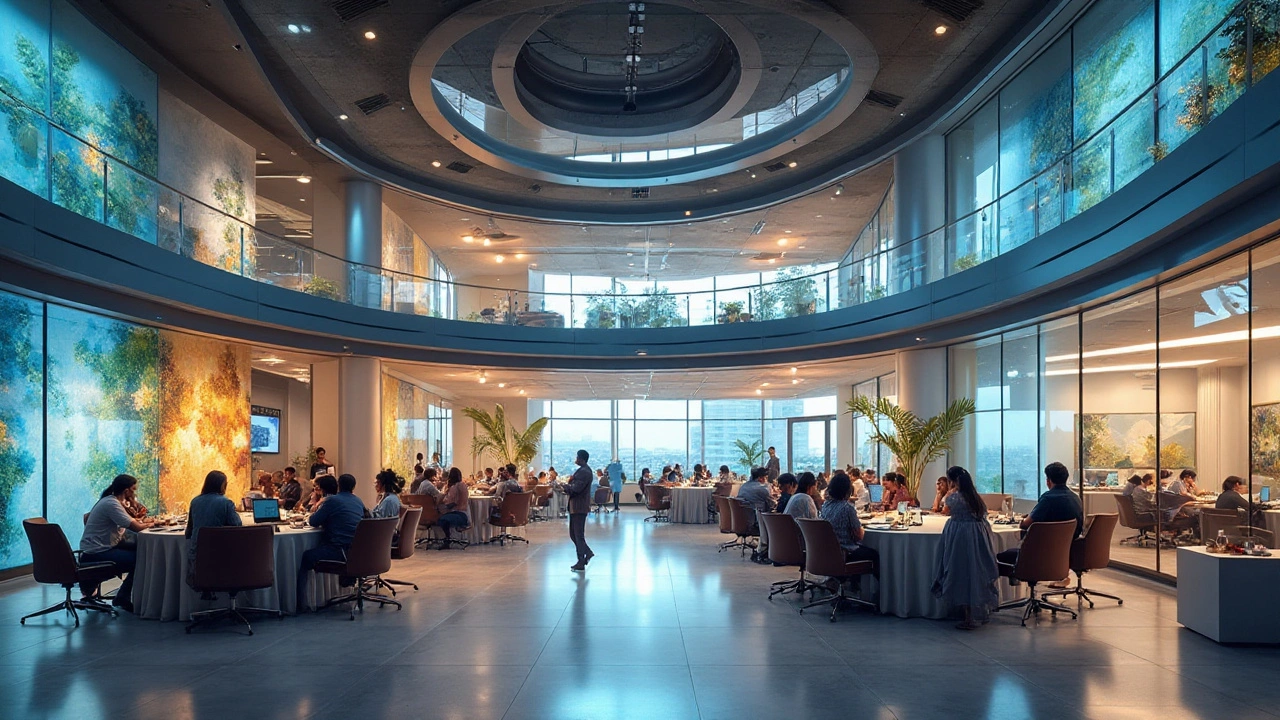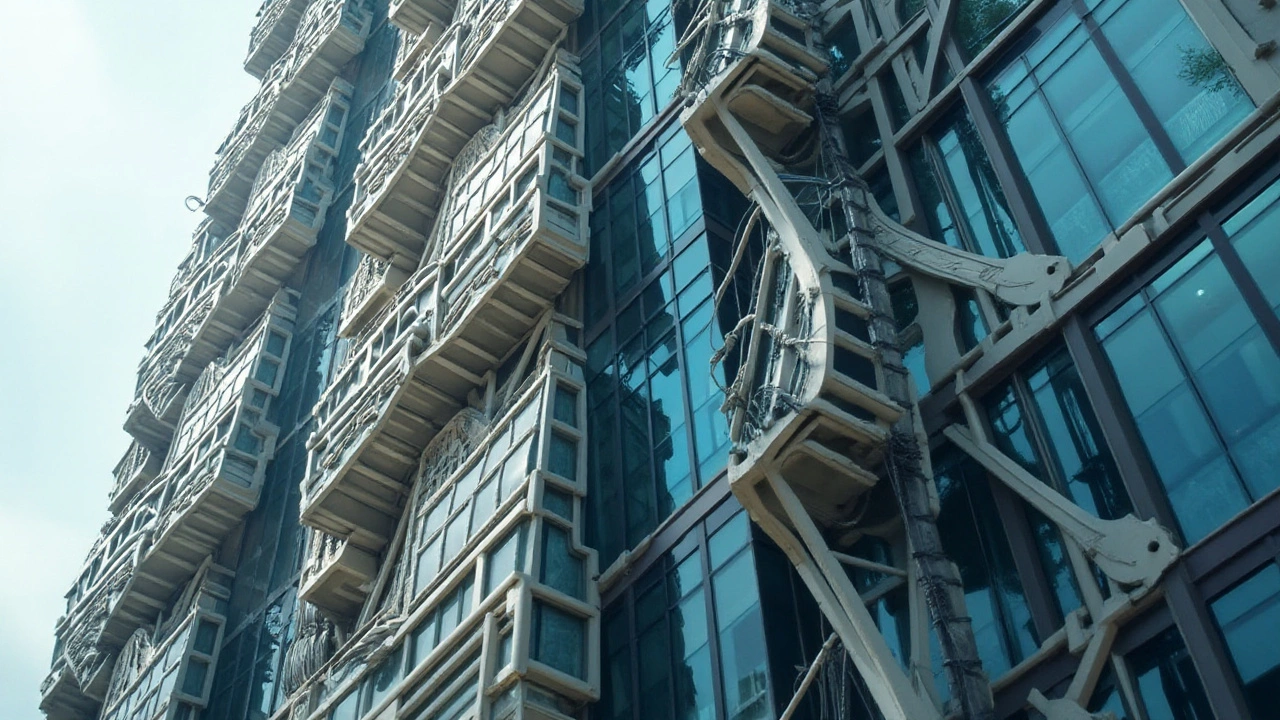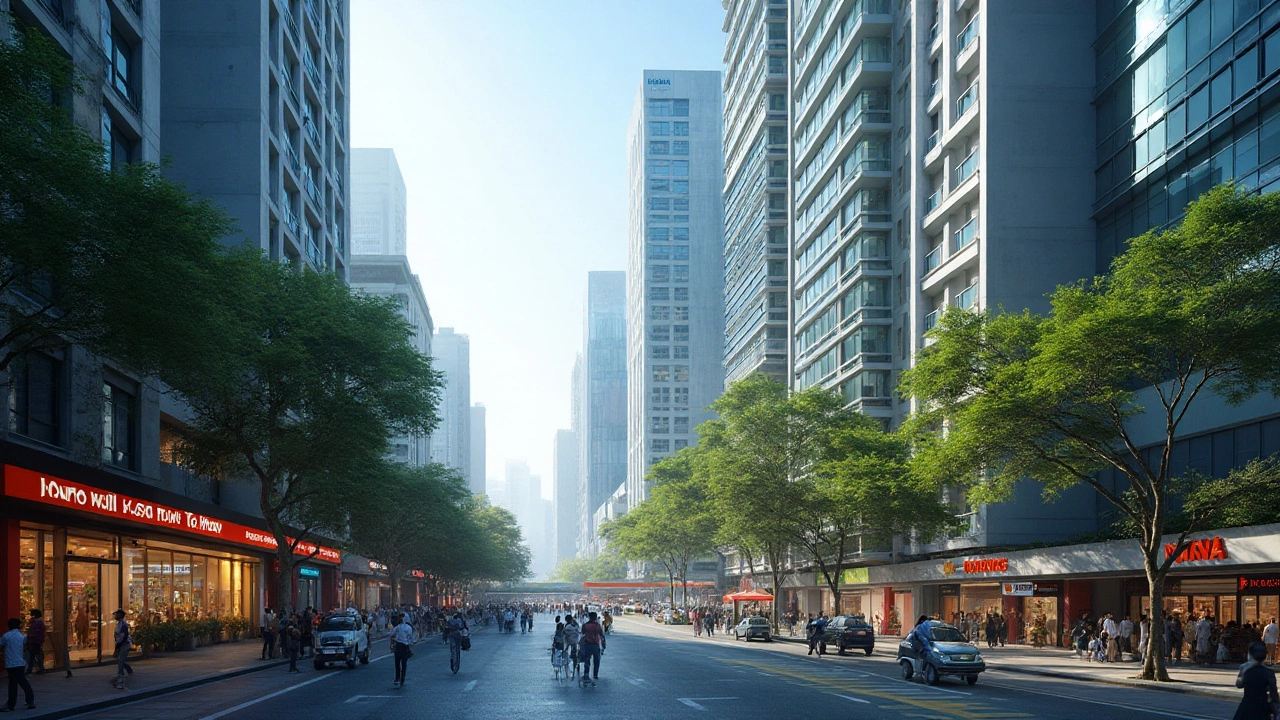The skyline of any bustling city is punctuated by towering giants made of steel and glass, but not all structures serve the same purpose. Commercial buildings hold a unique role as they are the lifeblood of economic activity, housing everything from corner shops to sprawling corporate headquarters. Yet, what truly sets them apart?
Understanding what makes a building commercial requires examining its intent and design. These structures are deliberately crafted to support business operations, offering spaces that cater to human activity within the spheres of trade and industry. From retail and offices to hotels and warehouses, the diversity is vast, yet unified by core principles in construction.
- Defining Commercial Buildings
- Key Characteristics and Features
- Design and Functionality
- Regulatory Considerations
- Trends in Commercial Construction
Defining Commercial Buildings
This subject demands a closer look at the intricate anatomy of what fundamentally classifies a structure as a commercial building. While residential constructions are designed with domestic life in mind, commercial buildings are the heartbeats of economic ecosystems. They are purpose-built to house spaces where transactions occur, ideas flourish, and services are provided, shaping them into pivotal environments that stimulate business lifecycles. From the flamboyant shopping centers offering a haven of retail therapy to the suave skyscrapers where decisions are made in air-conditioned boardrooms, each plays a role within a larger commercial context.
The classification of commercial buildings often hinges on the intention behind their construction and the activities they facilitate. Primary types include spaces that serve retail purposes, like malls and shops, offices that usher in collaboration and productivity, and facilities like hotels that cater to hospitality needs. Such buildings often adhere to stringent design specifications and regulatory standards to ensure they are fit for the intended use. A fascinating aspect is how these structures adapt to the continuously evolving commercial landscape, integrating contemporary design principles while maintaining functionality.
In a 2023 interview, renowned architect Frank Gehry stated,
"Commercial architecture is about finding a balance between creativity, practicality, and sustainability, offering not only a place of business but a platform that inspires efficiency and innovation."Gehry's viewpoint underscores the essence of design thinking in commercial spaces, where aesthetics meet pragmatism, empowering buildings to evolve along with the businesses they house. These buildings are more than just brick and mortar; they're interactive environments fostering relationships and growth. With urbanization accelerating, the need for commercial structures to be efficient and sustainable becomes critically important, pushing architects and developers to innovate continuously.
Commercial buildings are often characterized by distinct key elements that set them apart. For instance, the presence of large, open spaces becomes crucial in settings like exhibition halls, where interactions are intended to be seamless and fluid. Atriums and plazas are common architectural features that serve both aesthetic and functional purposes, ushering in natural light while providing communal zones. Venturing inside, these buildings tell a narrative through interior layouts designed to maximize workflow efficiency, for instance, the open-plan designs prevalent in most modern office complexes emphasize collaboration while balancing privacy through strategically incorporated quiet zones. As cities grow and reshape themselves, commercial buildings not only adapt to urban landscapes but often become icons that symbolize progress and prosperity within their respective locales.
Key Characteristics and Features
Commercial buildings are distinct in their design and purpose when compared to other structures. These buildings serve primarily business functions that range widely across industries. A critical feature is their ability to provide adaptable spaces to suit diverse needs, be it hosting retail environments, accommodating large office spaces, or even supporting mixed-use functionalities. This versatility is complemented by sturdy construction designed to support significant human footfall and dynamic activities.
The structure of a commercial building is engineered with state-of-the-art design principles. Architects incorporate sustainable practices to ensure energy efficiency, often implementing green building standards. Materials such as steel, concrete, and glass are typically chosen for their durability and minimal maintenance. The internal layout is intended to enhance productivity, with open spaces and ergonomic designs facilitating movement and interaction. As expressed by the renowned architect Frank Gehry,
“Architecture should speak of its time and place, but yearn for timelessness.”This concept is vividly illustrated in modern commercial architecture.
The architecture of these buildings often includes aesthetic features that reflect the brand identity of the businesses they house. Spaces are designed to be inclusive and adaptable, supporting varied technological needs and often incorporating elements such as high-speed internet connectivity and advanced lighting systems. Moreover, commercial buildings are characterized by their focus on safety and compliance, meeting rigorous building codes and standards to protect both the occupants and the environment. For instance, modern commercial buildings often feature robust fire safety systems, accessibility features for people with disabilities, and comprehensive security measures.
Modern technology's role in commercial building features cannot be overlooked. Smart systems regulate lighting, HVAC, and even monitor security systems remotely, paving the way for more efficient operations. Commercial constructions also take into account shifts in the labor market, like the increasing demand for co-working spaces which emphasizes communal areas over traditional office setups. This trend highlights a significant shift in construction and use paradigms, indicative of evolving work cultures and technological advancements. As per a recent report, around 70% of new commercial constructions integrate renewable energy sources and automated systems to reduce carbon footprints.
In essence, the defining characteristics of commercial buildings are their adaptability, durability, and technological integration. These features ensure that they not only meet the current needs of businesses but also anticipate future demands. The fusion of aesthetics, functionality, and sustainability continues to push the envelope in commercial construction, a testament to the ever-evolving landscape of commercial architecture.

Design and Functionality
When it comes to crafting commercial buildings, design and functionality are inseparable allies that define the very essence of these constructions. The true magic of commercial architecture comes alive in the balance between aesthetic allure and practical utility. Architects and designers work meticulously to ensure these spaces not only serve their primary purpose but also appeal to the senses and aspirations of those who occupy them. A commercial building must communicate a business's ethos and brand while accommodating varied functional needs under one roof. Whether it's the open-plan settings conducive to collaborative work in modern offices or the seamless flow of customer traffic in retail spaces, intentional design transforms these colossal structures into dynamic centers of activity.
Key to the design of any commercial building is its adaptability. Businesses grow and evolve, and so must their spaces. Flexible floor plans that allow for reconfiguration are an imperative. Trends such as modular design offer scalable solutions where spaces can be easily modified or expanded with minimal disruption. This versatility is especially crucial in sectors like retail and hospitality where changing consumer demands and preferences necessitate quick and efficient space alterations. There’s also an increasing emphasis on sustainability in design. Incorporating energy-efficient materials and technologies not only serves the environment but also reduces operational costs, which is a significant consideration in commercial construction.
"The best designs work to the rhythm of the people, not just the rhythm of the property," remarks Zaha Hadid, a renowned architect who pushed the boundaries of modern architecture.
Equally important is the structural integrity and safety of commercial buildings. They must comply with rigorous building codes and safety regulations. This often means equipping buildings with advanced fire safety systems, structural resilience against natural calamities, and ensuring accessibility for the disabled. These considerations must be integrated into the very blueprints of construction, influencing not just the building materials and methods used, but also their placement. Commercial construction is increasingly driven by data, utilizing smart building technologies that monitor and optimize the use of energy and space. This tech-driven approach provides a competitive edge by allowing owners and managers to make informed decisions that enhance both functionality and user experience.
Furthermore, examining the interplay between technological advancements and design offers a glimpse into the future of commercial construction. Smart technology is no longer a novelty but a necessity. From intelligent climate control systems that adjust heating and cooling based on occupancy patterns to security systems equipped with AI that enhance safety without sacrificing aesthetic appeal, the infusion of technology into design strategies leads commercial spaces to new heights. Enhanced connectivity in smart buildings also improves operational efficiencies, providing real-time data that informs space utilization, cost management, and even employee productivity. This leads to a working environment that optimizes human potential while maintaining energy efficiency.
Design must also take into account the emotional and psychological impact buildings have on occupants. Biophilic design, which seeks to incorporate natural elements into the built environment, is gaining traction. By blending vegetation, natural light, and water features into the design, commercial buildings can promote well-being and foster creativity among occupants. This approach is particularly effective in environments like offices and schools, where promoting wellness and reducing stress can directly correlate with performance outcomes. Finally, the exterior design of commercial buildings also plays a critical role in shaping public perception and establishing a brand's presence. Architectural choices, from facade patterns to color schemes, are carefully selected to stand out while blending harmoniously with the surrounding landscape, forming a lasting impression on passersby and potential clients alike.
Regulatory Considerations
Navigating the landscape of commercial construction unveils a realm where regulations play a pivotal role. Governments around the world enforce stringent laws to ensure safety, sustainability, and suitability in commercial buildings. These regulations, often dense and complex, dictate everything from the foundation depth to the types of materials used. A keen understanding of these rules is crucial not only for compliance but also to facilitate smooth construction operations. For instance, in many places, commercial properties must adhere to zoning laws which define the type of building that can exist in a particular area. Non-compliance can lead to legal setbacks, heavy fines, or even demolition orders, underscoring the importance of regulatory knowledge.
One of the pivotal elements of these regulations is ensuring fire safety. Modern commercial buildings must be equipped with sprinkler systems, specific fire-resistant materials, and clearly marked fire exits. In a tragic reminder of the past, the Grenfell Tower fire prompted tighter fire safety standards globally. Regulations now often mandate comprehensive fire risk assessments and the inclusion of advanced safety technology.
"Regulations are not just about compliance; they safeguard lives and drive innovation in construction," as highlighted by the International Code Council.Keeping up with such evolving standards means constructing more resilient and safer buildings.
Accessibility is another cornerstone of commercial building regulations. The goal is to make spaces usable and inclusive for everyone, regardless of ability. Laws such as the Americans with Disabilities Act (ADA) in the United States stipulate that public buildings must be accessible to individuals with disabilities. This includes installing elevators, ramps, and accessible bathrooms. Compliance extends beyond legal obligations; it opens businesses to a wider clientele and enhances their public image. In New Zealand, similar standards are set by the Building Act, ensuring that all new and renovated buildings meet prescribed accessibility requirements.
The push towards sustainability has introduced a new array of regulations in commercial construction. Governments are leaning on builders to adopt eco-friendly practices, reducing the carbon footprint of new developments. From incorporating energy-efficient systems to using sustainable materials, the goal is to create buildings that are environmentally responsible and resource-efficient. Several countries offer certifications like LEED (Leadership in Energy and Environmental Design) to encourage this shift. Meeting these green building standards not only helps the environment but can also provide financial incentives such as tax breaks or grants. The emphasis on sustainability reflects a global commitment to curb climate change impacts through thoughtful construction practices.
The dynamic nature of regulatory considerations means that constructors must stay educated and aware of the latest requirements. Attending workshops, seeking the expertise of specialized consultants, and maintaining open communication with local regulatory agencies are strategies businesses can employ to avoid pitfalls. Certain regions also provide digital resources and platforms where ongoing updates and supplementary explanatory notes for regulations are frequently published. These resources can be instrumental for both new players and seasoned veterans in the industry. As regulations continue to evolve, adapting proactively ensures that a commercial building project remains legally sound and successful.

Trends in Commercial Construction
Commercial construction is a dynamic arena, continuously evolving to keep pace with technological advances, environmental considerations, and shifting societal needs. One of the most prominent trends is the push towards sustainability. As environmental consciousness grows, businesses are keen to reduce their carbon footprint. This has led to the rise of green buildings, which prioritize energy efficiency, waste reduction, and sustainable materials. The use of solar panels, rainwater harvesting systems, and green roofing has become almost commonplace in new commercial projects.
Technology also plays a transformative role. The integration of smart building technology is reshaping commercial buildings, making them more efficient and responsive. These tech-enhanced spaces can automatically adjust lighting and temperature based on occupancy, leading to significant energy savings and improved comfort for occupants. The Internet of Things (IoT) is central to these advancements, connecting various building systems to create a seamless, automated environment.
"The future of commercial construction lies in smart, sustainable solutions that enhance both environmental responsibility and operational efficiency," says John Phillips, a leading industry analyst.
Another significant trend is the shift towards flexible and adaptive reuse of existing structures. Instead of building anew, developers are increasingly choosing to repurpose old buildings for commercial use. This not only preserves historical architecture but also offers an eco-friendly alternative to demolition and new construction. These projects often involve converting warehouses or factories into modern office spaces, co-working hubs, and boutique hotels.
The design approach is also evolving to support diverse work styles and promote collaboration. Open floor plans, modular furniture, and breakout spaces are becoming standard features. These elements contribute to a working environment that fosters creativity and interaction, which are critical in today's business world. The emphasis on biophilic design—integrating natural elements like plants and water features into interiors—further reflects a growing desire to create worker-friendly environments that enhance well-being.
Moreover, commercial construction is increasingly being shaped by the demands of mixed-use developments. These projects blend residential, commercial, and recreational spaces, offering a holistic living experience that aligns with urbanization trends. This integrated approach not only maximizes land use but also creates vibrant communities where residents can live, work, and play without needing to travel extensively.
One of the emerging areas of interest is the use of advanced data analytics in project management. Data-driven insights enable more accurate forecasting, budget management, and risk mitigation. Real-time data collection and analysis are fast becoming invaluable tools for making informed decisions throughout the construction process. As these technologies advance, their application is likely to deepen, revolutionizing every stage of commercial construction projects.

Written by Fletcher Abernathy
View all posts by: Fletcher Abernathy